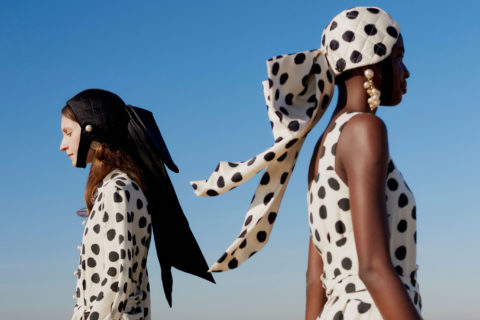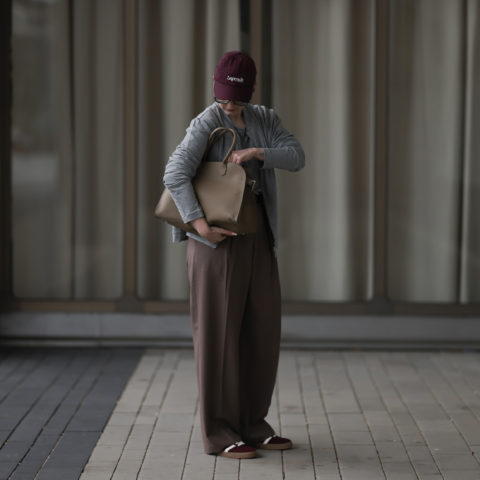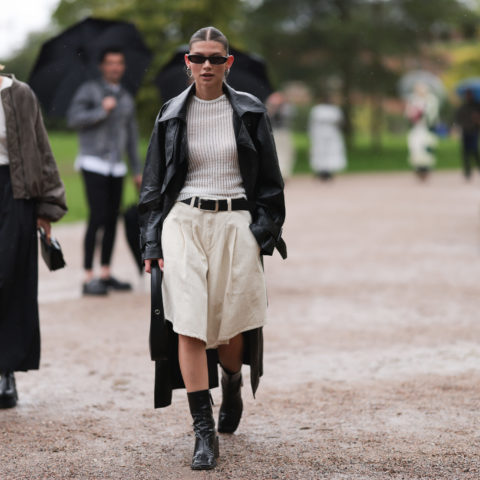Mother of Pearl’s Amy Powney on Why ‘Sustainable Equals Expensive’ Is a Myth
For the creative director of this London-based brand, a sustainability-driven passion project led to many revelations.
The fact that Mother of Pearl’s creative director Amy Powney recently launched a completely transparent, sustainable diffusion line should come as no surprise if you pause to think for a second about her upbringing. When she was 10 years old, her family moved from a house in Lancashire, England to a caravan on a five-acre field. Living off the grid, they had no running water or electricity; instead her father dug a borehole and erected a wind turbine to channel those resources. Powney credits her lifelong interest in sustainability to that formative experience.
“I wasn’t just able to turn my light switch on whenever I wanted to, water didn’t flow freely in our house, we had to go pump water from our well and it was then brought to the house,” she says in London, where her quirky presentation for the brand’s Fall ’19 collection is underway (there’s a giant ball pit of faux pearls involved). “And I think when something isn’t readily available it makes you think about where it comes from, and it changes the way you view something. I guess that’s when you stop taking it for granted.”
It’s what led her to make an organic, ethical clothing line for her graduate collection at Kingston University, and what brought her to Mother of Pearl in 2006 as an assistant.
“I thought, it’s a small company, we make quality product, print our silks in the UK, I know all the factories. From a corporate social responsibility level that was pretty good,” she tells the Guardian. “I wasn’t working for the high street or burning clothes. And I fell in love with the company.”
Over a decade later, she’s now creative director of the brand and in a position to undertake passion projects like No Frills, an entirely transparent, ethical and sustainable clothing line of elevated basics that launched last fall. Think jacquard jackets with pearl detailing on the sleeve, striped shirtdresses, oversized sweatshirts and flared jeans, all made from organic and ethically-sourced fabrics whose provenance is completely traceable from the field to the final product. A polka dot Tencel shirtdress on the brand’s website, for example, lists all its eco-friendly attributes: from the responsible use of water in its production cycle, to the digital printing which utilizes less water and ink, to the sustainable forestry methods. “For every tree cut down to make this fibre, new trees have been planted in its place and no ancient forests have been used,” it states.
“No Frills was our case study in a way, it was our learning program,” explains Powney. “Everything we learned from that we’ve [incorporated] into the Mother of Pearl line. Spring/summer ’19 is around 50% sustainable but the next summer collection we’re working on for 2020 is almost 80% sustainable. So we’re just working hard, we’re not perfect, nobody is, but we’re trying everything we can to turn a fully fledged brand into being as sustainable as possible.”
The resulting No Frills line of core pieces, available to shop online and at Canadian retailers like Bacci’s in Vancouver and Henriette L in Montreal, is cheaper to buy than the mainline collection (with prices from 150 CAD). So is the whole ‘sustainable means more expensive’ argument just a myth?
“I guess it depends on what sector you work in so in the luxury industry yes I think it’s a myth,” says Powney. “We reworked our supply chains and made sure that they were close together so if we’re going to grow cotton in Turkey for instance, is there a way we can also manufacture there? So it [lessens] the carbon footprint. And then we started trying to vertically integrate so we could own a few parts of the process and that actually reduces the price of the supply chain. So for us we found it was a lot cheaper. I think if you rethink the way you work, that is how you can make it efficient. Once you’ve rebuilt it and found that way to work then it just becomes innate, it’s just that we’ve been working in a vacuous way for way too long.”
Does she ever fantasize about living off the grid again one day?
“Definitely,” she answers instantly. “I’d love that. I’d still have to be able to come to London though, I couldn’t just go and never come back, I need both in my life. But for sure, if I had time I’d love to grow all my own food and live off grid. That would be my dream.”








